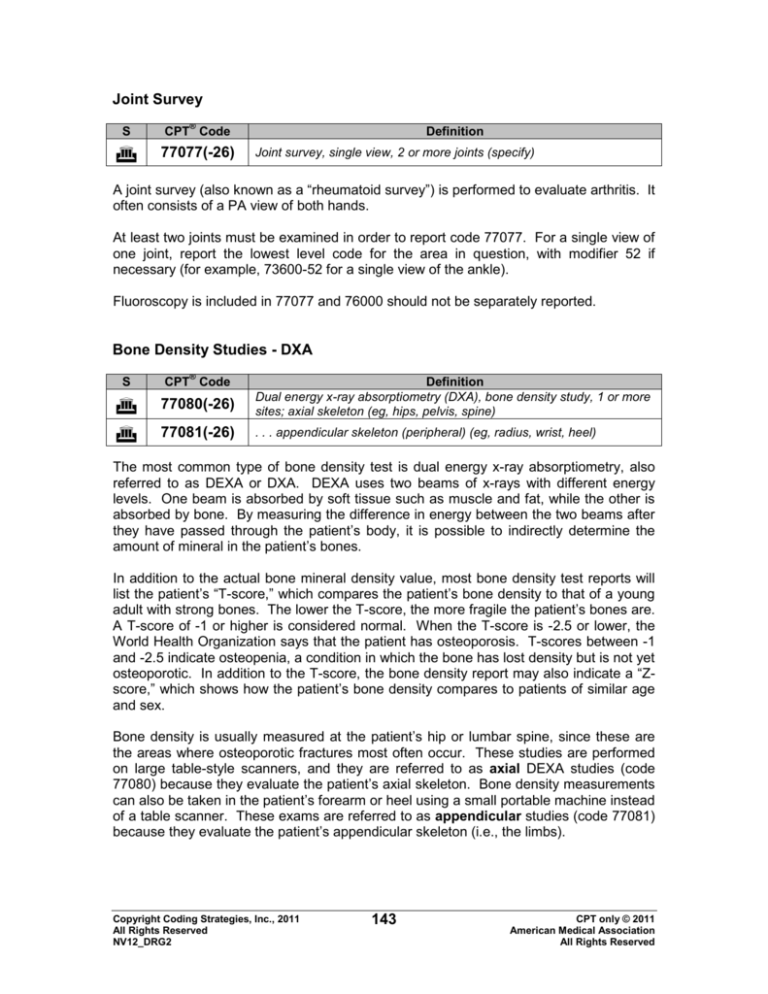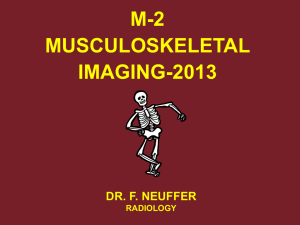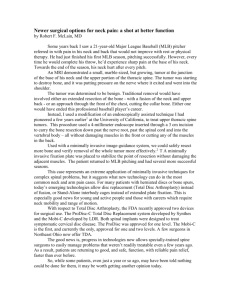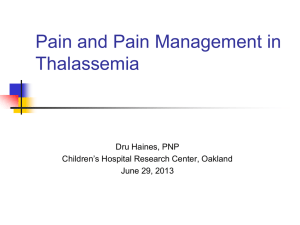
Joint Survey
®
S
CPT Code
77077(-26)
Definition
Joint survey, single view, 2 or more joints (specify)
A joint survey (also known as a “rheumatoid survey”) is performed to evaluate arthritis. It
often consists of a PA view of both hands.
At least two joints must be examined in order to report code 77077. For a single view of
one joint, report the lowest level code for the area in question, with modifier 52 if
necessary (for example, 73600-52 for a single view of the ankle).
Fluoroscopy is included in 77077 and 76000 should not be separately reported.
Bone Density Studies - DXA
®
S
CPT Code
77080(-26)
Definition
Dual energy x-ray absorptiometry (DXA), bone density study, 1 or more
sites; axial skeleton (eg, hips, pelvis, spine)
77081(-26)
. . . appendicular skeleton (peripheral) (eg, radius, wrist, heel)
The most common type of bone density test is dual energy x-ray absorptiometry, also
referred to as DEXA or DXA. DEXA uses two beams of x-rays with different energy
levels. One beam is absorbed by soft tissue such as muscle and fat, while the other is
absorbed by bone. By measuring the difference in energy between the two beams after
they have passed through the patient’s body, it is possible to indirectly determine the
amount of mineral in the patient’s bones.
In addition to the actual bone mineral density value, most bone density test reports will
list the patient’s “T-score,” which compares the patient’s bone density to that of a young
adult with strong bones. The lower the T-score, the more fragile the patient’s bones are.
A T-score of -1 or higher is considered normal. When the T-score is -2.5 or lower, the
World Health Organization says that the patient has osteoporosis. T-scores between -1
and -2.5 indicate osteopenia, a condition in which the bone has lost density but is not yet
osteoporotic. In addition to the T-score, the bone density report may also indicate a “Zscore,” which shows how the patient’s bone density compares to patients of similar age
and sex.
Bone density is usually measured at the patient’s hip or lumbar spine, since these are
the areas where osteoporotic fractures most often occur. These studies are performed
on large table-style scanners, and they are referred to as axial DEXA studies (code
77080) because they evaluate the patient’s axial skeleton. Bone density measurements
can also be taken in the patient’s forearm or heel using a small portable machine instead
of a table scanner. These exams are referred to as appendicular studies (code 77081)
because they evaluate the patient’s appendicular skeleton (i.e., the limbs).
Copyright Coding Strategies, Inc., 2011
All Rights Reserved
NV12_DRG2
143
CPT only © 2011
American Medical Association
All Rights Reserved
Spine MR
MRI of the Spine
MRI is effective in evaluating many different spine disorders, including disc
displacement, radiculopathy, suspected spinal cord compression, disc space infection,
etc. The exam may be performed with or without intravenous gadolinium. Intrathecal
contrast is seldom used for MRI of the spine.
The code assignment for MRI of the spine depends on the region of the spine that is
imaged and whether contrast is administered:
Protocol
Without contrast
With contrast
Without and with contrast
Cervical
72141
72142
72156
Thoracic
72146
72147
72157
Lumbar
72148
72149
72158
If all three levels of the spine are imaged, three codes would be assigned. For example,
if the cervical, thoracic and lumbar spine are all imaged without contrast material, you
would assign 72141, 72146, and 72148.
MRA of the Spinal Canal and Contents (72159)
In the past, MRA of the spinal canal was non-covered by Medicare under a National
Coverage Determination (NCD). Effective June 3, 2010, these studies can be covered
at the discretion of the local Medicare contractor. Please refer to your contractor’s
published coverage policies to see if the exam is covered in your area.
Physicians and non-hospital imaging centers should report code 72159 for MRA of the
spinal canal. Hospitals billing under the Outpatient Prospective Payment System must
report one of the following HCPCS codes instead of code 72159:
S
HCPCS Code
C8931
C8932
C8933
Definition
Magnetic resonance angiography with contrast, spinal canal and
contents
Magnetic resonance angiography without contrast, spinal canal and
contents
Magnetic resonance angiography without contrast followed by with
contrast, spinal canal and contents
MRI of the Pelvis (72195 - 72197)
MRI of the pelvis typically includes evaluation of the bladder, prostate, ovaries, uterus,
lower retroperitoneum, and iliac lymph nodes. It is performed to evaluate adnexal
masses, carcinoma of the female pelvis, leiomyomas, adenomyosis, pelvimetry, staging
prostate carcinoma, testicular masses.
Copyright Coding Strategies, Inc., 2011
All Rights Reserved
NV12_DRG2
263
CPT only © 2011
American Medical Association
All Rights Reserved









